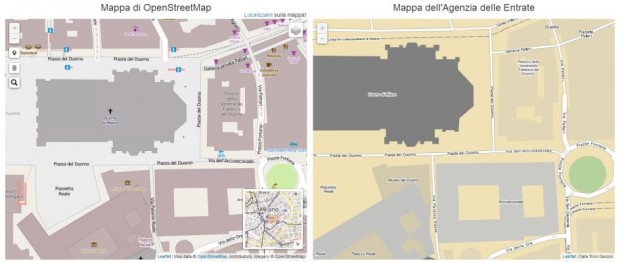A couple of months ago, Simone Cortesi, deputy president of Wikimedia Italia and the primus inter mappers of Italy’s geohackers, noticed an oddity in the maps of the Revenue Agency’s property market dataset. How could they know about the walkways in his own garden? He realized he himself had uploaded those data, not into any government dataset but into the “wikipedia of maps”, OpenStreetMap. Since the maps did not credit OSM as the data source, the Revenue Agency was technically infringing on OSM’s intellectual property rights. OSM maps are free to use for all, but if you do use them you must respect the terms of the Open Database License protecting the data. If Simone’s allegations proved to be correct, this would be the largest ever copyright infringement against OpenStreetMap. And done by the tax authority of a G8 country, no less.
A group of Italian expert contributors to OSM coded a website exposing the problem and containing a tool for comparing the Revenue Agency’s “proprietary” maps with OpenStreetMap. Hundreds of eyeballs were put on the case, and sure enough, the data are the same, and the copyright infringement was there.
On July 8th 2014, after the Italian Twittersphere had put the word out, the Revenue Agency tweeted back that it had “demanded an explanation” from its technology provider, a company called Sogei. This is an in-house company, 100% owned by the Ministry of Treasury. Later in the day, Sogei complied with the terms of the OpenStreetMap license and issued a statement of apologies. With this, the generous Italian mappers declared themselves vindicated. Simone, bless him, rose to the occasion to demand the Agency opens up its own data, specifically those of the real estate registrar, as he and many of us in the Italian open data community have been advocating for years.
Over and above the embarassment, there is a deeper lesson to learn here. Sogei is a monopolist: the Revenue Agency had no choice but to get its tech from them. Sogei, in turn, ostensibly acquired their geodata from a company called Navteq, (source, in Italian), owned by Nokia (wikipedia), that appears since to have changed its name into Here.
So what happened, really? Did Navteq repackage free and open data and sell them as proprietary to Sogei, who resold them back to the Italian state? How much money was spent on this procurement process? Was there financial damage to the public purse, and was it intentional (hence an offence)? How much money could we have saved, and keep saving, if smart communities like the OSM, open source and open data communities were involved in public procurement?

It is extremely unlikely that Sogei bought OSM data from HERE.
Far more likely is that Sogei bought NAVTEQ data for the base map (as the Italian article you linked seems to claim) then combined it with OSM data, which is exactly what the article seems to indicate is being done intentionally: “the idea is to allow different departments to work together, overlapping the layers and layers of mapping information” (“l’idea è quella di consentire a uffici diversi di lavorare assieme, sovrapponendo alla cartografia strati e strati di informazioni”).
The NAVTEQ base map likely provides the graph/road network, and some agency requested the higher-density OSM data to be added in. Given Sogei’s apology, I think any other idea (like the idea that HERE provided OSM data without an appropriate license) is not credible.
Hello Christopher, that sounds plausible. A question: why do you think the decision was not made to use OSM data as the base map? That would have meant, among other things, contributing to OSM’s coverage of Italy, adding to a digital commons etc.
At the end of the day, I have to assume the Revenue Agency did not know they were using OSM (this is consistent with their tweet “we asked SOGEI for an explanation”). Somewhere along the Navteq-Sogei-Revenue Agency chain, someone pulled those data in and did not give credit. If we could see the contract and invoice underpinning this transaction, we would know whether that someone was charging her customer simply for the person-months or for the IP too. And this is what I am asking.